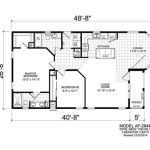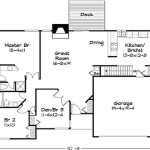20 Foot Container Home Plans: A Compact and Efficient Housing Solution
The concept of container homes has gained significant traction in recent years as a viable and sustainable alternative to traditional housing. Among the various sizes of shipping containers, the 20-foot container stands out as a particularly attractive option for those seeking a compact, affordable, and easily transportable dwelling. The development of well-designed 20-foot container home plans is crucial for maximizing the potential of these structures and creating functional and comfortable living spaces.
A 20-foot shipping container, typically measuring 20 feet long, 8 feet wide, and 8.5 feet high, offers approximately 160 square feet of interior space. While this may seem limited, careful planning and innovative design can transform a 20-foot container into a surprisingly livable residence. The inherent structural integrity of shipping containers also provides a solid foundation for constructing a durable and weather-resistant home. The utilization of 20-foot container home plans can lead to the creation of efficient and cost-effective housing solutions for a variety of needs.
Understanding the Basics of 20-Foot Container Homes
Before delving into specific plans, it's essential to understand the fundamental principles that govern the design and construction of 20-foot container homes. These principles encompass structural considerations, insulation techniques, ventilation strategies, and compliance with local building codes.
The structural integrity of the container itself is a crucial factor. While the corrugated steel walls provide significant strength, modifications such as cutting openings for doors and windows can compromise this integrity. Therefore, structural reinforcement may be necessary, particularly around the openings, to ensure the container's stability and prevent deformation over time. This often involves welding steel framing or incorporating other reinforcing elements into the design. Qualified engineers should be consulted to assess the structural impact of any modifications and to provide appropriate recommendations for reinforcement.
Insulation is another critical aspect of 20-foot container home design. Steel is a poor insulator and is highly susceptible to temperature fluctuations. Without proper insulation, the interior of the container can become unbearably hot in the summer and extremely cold in the winter. Various insulation methods can be employed, including spray foam insulation, rigid foam boards, and batt insulation. The choice of insulation material will depend on factors such as climate, budget, and desired energy efficiency. Proper installation is essential to prevent moisture buildup and mold growth, which can compromise the health and safety of the occupants. A vapor barrier should be incorporated into the insulation system to control moisture migration.
Ventilation is equally important for maintaining a comfortable and healthy indoor environment. Adequate ventilation helps to remove stale air, reduce humidity, and prevent the buildup of pollutants. Natural ventilation can be achieved through the strategic placement of windows and vents, allowing for cross-ventilation throughout the container. Mechanical ventilation systems, such as exhaust fans and heat recovery ventilators (HRVs), can also be used to supplement natural ventilation and ensure adequate air circulation, especially in climates with extreme temperatures or high humidity. The location and size of ventilation openings should be carefully considered to maximize their effectiveness and minimize energy loss.
Finally, compliance with local building codes is paramount. Container homes are subject to the same building codes as traditional homes, and it is essential to obtain the necessary permits and approvals before commencing construction. Building codes vary depending on location, and they may address issues such as structural integrity, fire safety, electrical wiring, plumbing, and accessibility. Consulting with local building officials early in the design process can help to ensure that the container home meets all applicable code requirements and avoid costly delays or modifications later on.
Key Considerations for Designing 20-Foot Container Home Plans
Designing effective 20-foot container home plans requires careful consideration of several key factors, including space optimization, functionality, aesthetics, and sustainability. The limited square footage necessitates creative solutions for maximizing space and creating a comfortable and functional living environment.
Space optimization is crucial in a 20-foot container home. Multifunctional furniture, such as sofa beds, folding tables, and storage ottomans, can help to maximize the use of available space. Vertical storage solutions, such as shelving units and wall-mounted cabinets, can also free up floor space and provide ample storage. Utilizing the height of the container is essential for creating a sense of spaciousness. Lofts can be incorporated to provide additional sleeping or storage space, while high ceilings can enhance the feeling of openness. Careful planning of the layout and furniture placement is essential to ensure that the limited space is used efficiently and effectively. The use of sliding doors instead of swinging doors can also save valuable floor space.
Functionality is another important consideration. The plan should prioritize the essential functions of a home, such as sleeping, cooking, bathing, and relaxing. A well-designed kitchen should include adequate counter space, storage, and appliances. A small bathroom with a shower, toilet, and sink should be incorporated. A comfortable living area with seating and entertainment options should also be included. The plan should also consider the placement of electrical outlets, lighting fixtures, and plumbing connections to ensure that the home is functional and convenient. Accessibility should also be considered, particularly for individuals with mobility limitations.
Aesthetics play a significant role in the overall appeal of a 20-foot container home. While functionality is essential, the plan should also incorporate design elements that enhance the visual appeal and create a welcoming and comfortable atmosphere. The use of natural light can significantly brighten the interior and create a sense of spaciousness. Large windows and skylights can be incorporated to maximize natural light. The choice of colors, materials, and finishes can also have a significant impact on the overall aesthetic. Light colors can make the space feel larger and brighter, while warm colors can create a cozy and inviting atmosphere. The exterior of the container can also be customized with paint, cladding, or landscaping to enhance its curb appeal and blend it with the surrounding environment.
Sustainability is an increasingly important consideration in housing design. Container homes are inherently sustainable because they repurpose existing shipping containers, reducing the demand for new building materials. However, it is also important to incorporate other sustainable design features, such as energy-efficient appliances, water-saving fixtures, and renewable energy systems. Solar panels can be installed on the roof to generate electricity, while rainwater harvesting systems can be used to collect and store rainwater for irrigation or other non-potable uses. The use of recycled or reclaimed materials can also reduce the environmental impact of the construction process. By incorporating sustainable design principles, 20-foot container homes can be both environmentally friendly and cost-effective.
Examples of 20-Foot Container Home Plan Layouts
Numerous variations of 20-foot container home plans exist, each tailored to different needs and preferences. These plans often incorporate clever design solutions to maximize space and functionality. Some common layout examples include studio apartments, tiny houses, and guest houses.
A studio apartment layout typically combines the living, sleeping, and kitchen areas into a single open space. A small bathroom is usually located at one end of the container. This layout is ideal for individuals seeking a minimalist and affordable living space. The open floor plan allows for flexibility in arranging furniture and creating distinct zones for different activities. The kitchen area may be equipped with a small refrigerator, a cooktop, and a sink. The sleeping area may feature a sofa bed or a Murphy bed to maximize space during the day. Storage can be incorporated into the walls or under the bed to minimize clutter.
A tiny house layout may include separate living, sleeping, and kitchen areas, albeit in a compact form. A loft may be used for the sleeping area to free up floor space for the living and kitchen areas. A small bathroom with a shower, toilet, and sink is typically included. This layout is suitable for individuals or couples seeking a more comfortable and functional living space. The separate living and sleeping areas provide greater privacy and allow for more distinct separation of activities. The kitchen area may be equipped with a larger refrigerator, a stove, and a microwave. The living area may feature a small sofa, a coffee table, and a TV. The loft can be accessed by a ladder or a staircase.
A guest house layout may include a bedroom, a bathroom, and a small living area. A small kitchenette may also be included. This layout is ideal for providing comfortable accommodations for guests or as a rental unit. The bedroom may feature a queen-sized bed and a closet. The bathroom may include a shower, a toilet, and a sink. The living area may feature a sofa, a coffee table, and a TV. The kitchenette may include a small refrigerator, a microwave, and a sink. A separate entrance may be incorporated to provide privacy for guests.
These are just a few examples of the many possible layouts for 20-foot container homes. The specific layout will depend on the individual needs and preferences of the occupants. It is important to carefully consider the available space, the desired functionality, and the overall aesthetic when designing a 20-foot container home plan. Working with a qualified architect or designer can help to ensure that the plan is well-designed, functional, and aesthetically pleasing.
In conclusion, the 20-foot shipping container offers a viable and attractive option for creating compact and affordable housing. Through careful planning and innovative design, these containers can be transformed into comfortable and functional living spaces. By understanding the basics of container home construction, considering key design factors, and exploring various layout options, individuals can develop effective 20-foot container home plans that meet their specific needs and preferences.

Pro Tips Tricks For Planning A 20 Foot Container Home Cedreo

8x20 Container Floor Plans

My Favourite 3 Designs From Tinyhouseliving 20ft Container

Two 20ft Containers House Floor Plans With 2 Bedrooms

Pro Tips Tricks For Planning A 20 Foot Container Home Cedreo

Construction Plan 14 4 Buddy 20 Foot Container Home House Plans Blueprints Feet Inches Metric Sizes Hurry

Sleek 20ft Container Home Plans B5

Buy A 20ft Tiny Container Home Box Al S

Single 20ft Container

Construction Plan 14 4 Buddy 20 Foot Container Home House Plans Blueprints Feet Inches Metric Sizes Hurry








